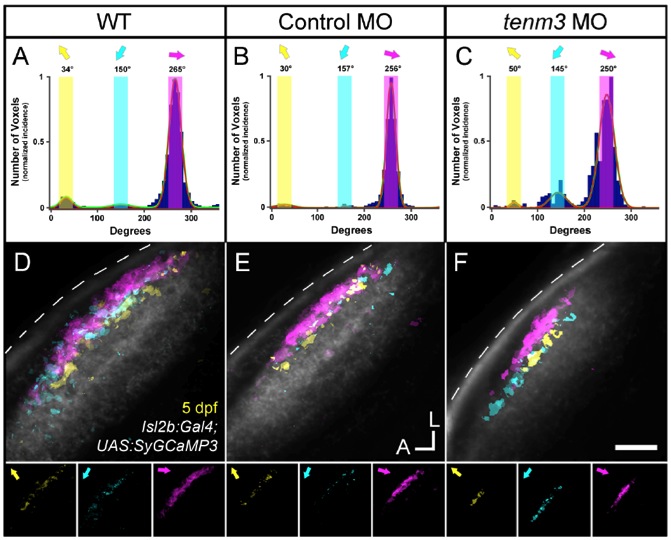Fig. S3
The Three Direction-Selective RGC Subtypes Are Not Affected by teneurin-3 Knock-Down, Related to Figure 5
(A-C) Cumulative histograms summarizing the incidence of direction-selective (DS) voxels within each group (WT n = 8 larvae; control MO n = 11; tenm3 MO n = 20). Fitted von-Mises distributions reveal three populations of DS voxels tuned to three different directions of motion. Individual peak preferred angles are reported above. Note that all three animal groups develop three DS RGC subtypes. Moreover, the sizes of individual DS voxel populations are comparable across groups, with the dominant input corresponding to anterior motion selectivity. (D-F) Composite parametric maps across multiple 5 dpf larvae representing the spatial distribution of the three DS voxel subtypes within each group (WT n = 8 larvae; control MO n = 11; tenm3 MO n = 20). Note that the laminar organization of the three DS voxel subtypes in the tectal neuropil is analogous in all three groups, namely they are confined to superficial layers of the SFGS. Individual parametric maps for each voxel subtype are shown at the bottom. Color coding as per (A-C). The standard space template image derived for each group (greyscale) provides an anatomical reference. Dashed lines indicate the skin overlaying the tectum. Scale bar = 20 μm. A, anterior; L, lateral.
Image
Figure Caption
Acknowledgments
This image is the copyrighted work of the attributed author or publisher, and
ZFIN has permission only to display this image to its users.
Additional permissions should be obtained from the applicable author or publisher of the image.
Full text @ Cell Rep.

